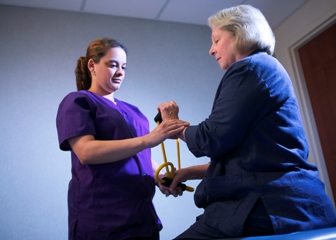
Occupational therapists use special equipment to help children with developmental disabilities.
Occupational therapists treat patients with injuries, illnesses, or disabilities through the therapeutic use of everyday activities. They help these patients develop, recover, and improve the skills needed for daily living and working.
Duties
Occupational therapists typically do the following:
- Observe patients doing tasks, ask the patient questions, and review the patient's medical history
- Use the observations, answers, and medical history to evaluate the patient's condition and needs
- Establish a treatment plan for patients, laying out the types of activities and specific goals to be accomplished
- Help people with various disabilities with different tasks, such as helping an older person with poor memory use a computer, or leading an autistic child in play activities
- Demonstrate exercises that can help relieve pain for people with chronic conditions, such as joint stretches for arthritis sufferers
- Evaluate a patient’s home or workplace and identify how it can be better suited to the patient’s health needs
- Educate a patient’s family and employer about how to accommodate and care for the patient
- Recommend special equipment, such as wheelchairs and eating aids, and instruct patients how to use that equipment
- Assess and record patients’ activities and progress for evaluating clients, for billing, and for reporting to physicians and other healthcare providers
Patients with permanent disabilities, such as cerebral palsy, often need help performing daily tasks. Therapists show patients how to use appropriate adaptive equipment, such as leg or knee braces, wheelchairs, and eating aids. Patients can function independently and control their living environment by using these devices.
Some occupational therapists work in educational settings with children one on one or in small groups. They evaluate disabled children’s abilities, modify classroom equipment to accommodate certain disabilities, and help children participate in school activities.
Some therapists provide early intervention therapy to infants and toddlers who have, or are at risk of having, developmental delays.
Therapists who work with the elderly help their patients lead more independent and active lives. They assess the patient’s abilities and environment and make recommendations, such as using adaptive equipment or identifying and removing potential fall hazards in the home.
In some cases, occupational therapists help patients create functional work environments. They evaluate the work space, plan work activities, and meet with the patient’s employer to collaborate on changes to the patient’s work environment or schedule.
Occupational therapists also may work in mental health settings where they help patients who suffer from developmental disabilities, mental illness, or emotional problems. They help these patients cope with and engage in daily life by teaching skills such as time management, budgeting, using public transportation, and doing household chores. Additionally, therapists may work with individuals who have problems with drug abuse, alcoholism, depression, or suffer from other disorders.
Some occupational therapists—such as those employed in hospitals or physicians’ offices—work as part of a healthcare team, along with doctors, registered nurses, and other types of therapists. They also may oversee the work of occupational therapy assistants and aides. For more information, see the profile on occupational therapy assistants and aides.









